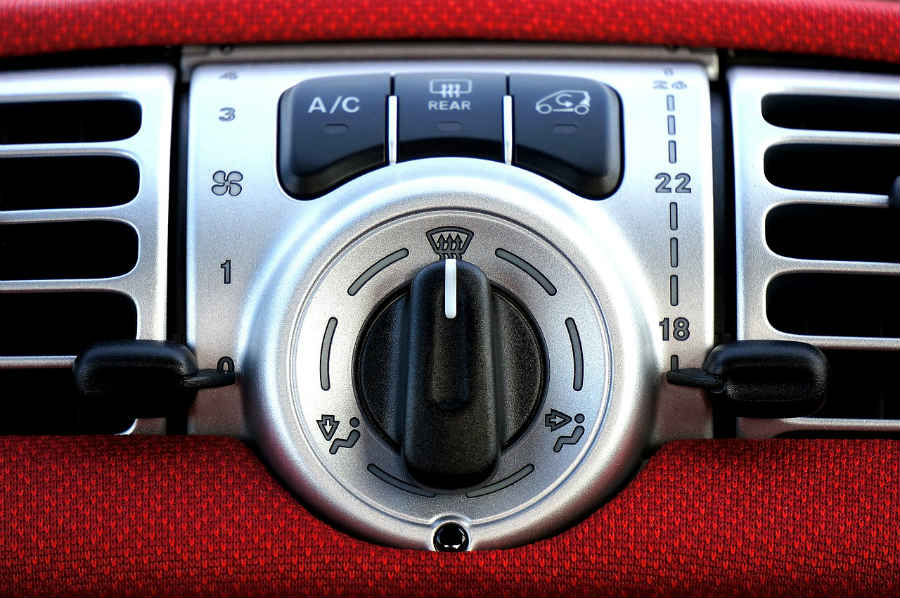The air conditioner system is made with several different components that all work together to create cold air. The evaporator is the component that causes heat to be transferred from the cabin to the air conditioning system which creates cooler air.
When replacement becomes inevitable, removing the entire dash is a lengthy job and is much more costly than one with an access panel. Dashboard removal requires the steering column to be removed and sometimes, even the front seats and consoles.
Because the evaporator is located inside the heater box, the cost is heavily dependent on whether or not the dashboard must be removed in order to replace it. Removing the evaporator also requires an evac and recharge to be performed as an additional cost. The refrigerant must always be removed first prior to servicing an AC component.
What’s the Price of an AC Evaporator Replacement?
Assume $100 per hour for an independent shop and $150 per hour for dealerships for these estimates:
For the evaporator coil replacement cost on a 2010 Honda CR-V, the book time is 3.6 hours of labor. This vehicle utilizes an access panel that allows the evaporator to be replaced without dashboard removal.
Labor cost at an independent shop would be around $360 and an aftermarket evaporator would range between $40 and $65 depending on the brand. Because this vehicle requires the evaporator to be removed to replace the expansion valve, it is a good idea to replace it at this time. An aftermarket expansion valve would range between $25 and $50 extra.
For the same 2010 Honda CR-V to be serviced at the dealership, the labor cost would be around $450 and a Honda evaporator would range between $250 and $375 depending on the markup. To replace the expansion valve, the additional part cost would range between $100 and $175 depending on location and markup.
On a 2016 Honda Civic, the evaporator calls for 8.4 hours of labor. Although this vehicle is from the same manufacturer, there is no access panel and the dashboard must be removed. For this reason, it comes with a much higher labor cost.
At an independent shop, this Civic would cost $840 just for labor. The aftermarket evaporator would range between $40 and $70 and the expansion valve would range between $30 and $55 depending on the brand.
At the dealership, the evaporator coil leak repair cost for this Civic would run up a bill of $1,260 just for labor. The evaporator would range between $225 and $400 and the expansion valve would range between $100 and $175.
If the dashboard is to be removed, it is highly recommended that it is performed at the dealership to ensure that your dashboard is reinstalled properly to prevent rattle noises or damage to the electrical harness if it is not routed properly on reinstallation.
For a 2012 Chevrolet Impala, the book time is 8.4 hours of labor and the dashboard must be removed.
At an independent shop, the labor would cost around $840 and for an aftermarket evaporator, it can run between $60 and $100. On this vehicle, the expansion valve can be serviced without removing the evaporator, so it is not necessary to replace it at this time. It can be replaced as a precaution and could save you 2 hours of labor if it did fail later on for only $20 to $50 additionally.
At the dealership, this Impala would cost $1,260 in labor and a Chevy evaporator would range between $220 and $375 depending on location and markup. To replace the expansion valve, the additional cost would be between $75 and $125.
More About AC Evaporator
The evaporator is essentially a heat exchanger as it uses the cold refrigerant to absorb the hot interior air to cool down the passengers.
The evaporator also functions as a dehumidifier. Many manufacturers will use the air conditioning when you set your vehicle to defrost or windshield mode in the winter seasons. As the cold evaporator absorbs heat, it causes moisture to condense and drain out of the bottom of the vehicle through a drain tube.
The evaporator is located inside the heater box or the HVAC box. This box consists of all the ductwork and doors to direct your air through the selected vents. The heater box also houses the heater core which is how you get hot air through the use of your engine’s coolant.
The heater box is located behind the dashboard assembly. On some vehicles, it is possible to remove the heater core or the evaporator through an access panel on the heater box. On other vehicles, the entire dashboard must be removed to gain access to the evaporator.
Why Would You Need Your Evaporator Replaced?
The most common reason to replace your evaporator is due to leakage. It can be hard to diagnose a leaking evaporator as it can’t be seen by technicians since it sits inside the heater box. Thankfully, if the AC system has fluorescent dye in the system, it can sometimes be seen dripping out of the drain tube on the underside of the vehicle.
The drain tube eliminates the water that accumulates inside the heater box due to condensation. If the evaporator is leaking, the dye can work its way down the heater box and be seen leaking out of the drain tube with the excess water from condensation.
The other cause but not as common is a clogged evaporator. Since the evaporator causes water to condense on it, it’s possible that dirt and dust in the air can become embedded into the evaporator fins. When dirt becomes embedded into the fins, it can cause the evaporator to cool less efficiently.
The dust and dirt in the air can also cause a clog in the drain tube. When this happens usually a sloshing sound can be heard inside the dash or sometimes the floor can become wet as the water cannot drain out of the heater box.
The best way to prevent dirt and dust from accumulating on or in the heater box is to always replace your cabin air filter (also called an AC filter). This filter helps prevent this from happening as well as keep the air inside the car clean. Most manufacturers recommend replacing your cabin filter every 15k miles.
Mildew Smell From Vents
Sometimes in humid weather, you may notice a mildew smell coming from your vents when first turning your car on. Sometimes this can be an indication of a blockage in the evaporator drain tube, but sometimes it’s just how the heater box is designed.
There is a helpful trick to prevent this smell if your drain tube is not clogged. This helpful trick works on most vehicles and can help reduce mildew smells.
When approaching your final destination (5 minutes or longer) turn off the air conditioning system and roll down the windows. This helps evaporate any water that is inside the heater box that has not yet been drained out. It’s the water that doesn’t drain out that causes the smell the next day after sitting overnight.
Due to heater box designs, this may not always work as water can remain trapped in pockets that are too shallow to drain out. There are also aftermarket sprays that can be sprayed into the vents to help counteract this smell.

